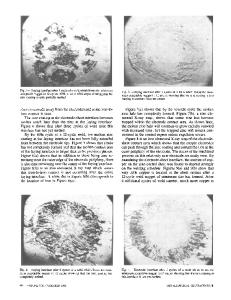Microstructural Analysis of Cavity Formed in Advanced High-Strength Steel Resistance Spot Welds
- PDF / 1,517,268 Bytes
- 6 Pages / 593.972 x 792 pts Page_size
- 26 Downloads / 303 Views
JMEPEG https://doi.org/10.1007/s11665-020-05139-4
Microstructural Analysis of Cavity Formed in Advanced High-Strength Steel Resistance Spot Welds Vijeesh Vijayan
, Sivaprasad Murugan, Seong-Guk Son, and Yeong-Do Park
(Submitted May 22, 2020; in revised form August 19, 2020) Resistance spot welding (RSW) is an autogenous welding process used to lap weld sheet metals. The coalescence obtained by melting and solidifying a small region by passing very high currents using copper electrodes is known as a nugget. The strength of the spot welds is entirely dependent on these nuggets, and any reduction in the size of it may result in the reduction in its load-carrying capacity. Cavity/void is a defect formed in RSW nugget that reduces its load-carrying area. Although cavities are formed in all grades of steels, it has a devastating effect in advanced high-strength steels (AHSS). However, it is yet to understand the exact mechanism of its formation and influence on mechanical properties of AHSS spots. In this context, the present paper is aimed at carrying out an extensive microstructural and computed tomography analysis of the cavities formed in the AHSS spots to understand its mechanism of formation. The results indicate that the cavities formed in AHSS had two distinctive regions: (1) an equiaxed dendritic region with smooth edges and surfaces, which occupied a larger portion of the void, and (2) a rough and irregular dendritic region with dendritic gaps. A thorough microstructural analysis revealed that the dendrites, which grew inwards in the smooth region of the cavity is nucleated from the cavity, indicates the presence of porosity in nugget prior to the start of solidification, while the dendrites of the rough region grew and the dendritic gaps between them indicates the role of thermal contraction in void formation towards the end of solidification. Keywords
computed tomography (CT), defect, dual phase steel (DP), high Mn steel, void
1. Introduction Resistance spot welding (RSW) is a widely used joining process in automobile industry especially in welding car body-in-white parts (Ref 1, 2). The coalescence between steel sheets is obtained by passing very high currents through a small region with the help of copper electrodes. Owing to jouleÕs heating, a small region at the sheet interface (known as nugget) is heated beyond its melting temperature and then cooled to form a coalescence. However, the solidification of the nugget begins from the periphery and proceeds inward toward nugget center, making it the last region to solidify. A void/cavity is commonly observed in this center portion of the nugget. It is deduced that such cavities are formed because of the material deficit caused due to the subsequent action of dendritic coherency and material contraction (Ref 3, 4). Figure 1 schematically illustrates the deduced mechanism of shrinkage cavity formation in resistance spot welds. Although shrinkage cavity is not uncommon in RSW, the literature is scant on its behavior and characteristics. Authors have earlier repo
Data Loading...











